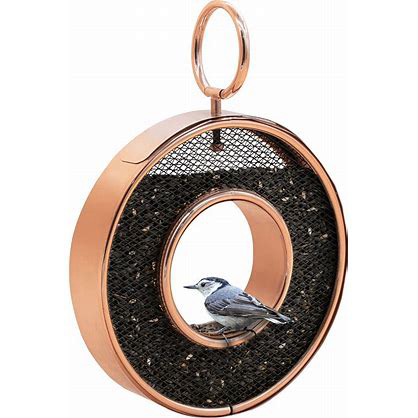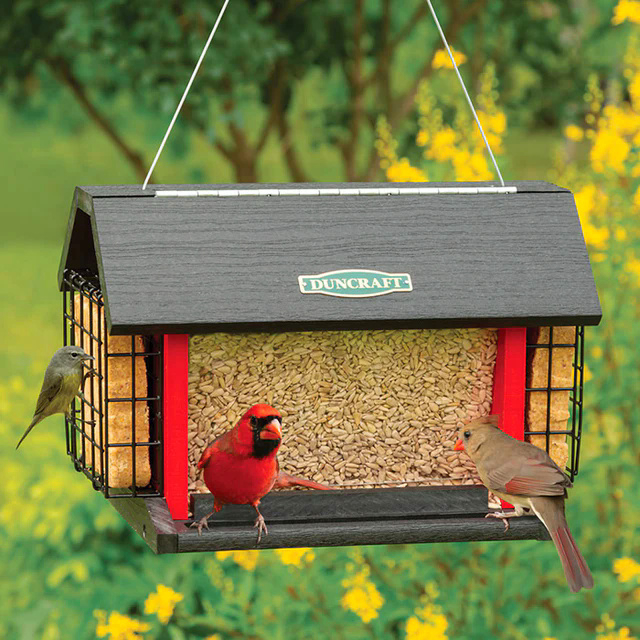
Almost any larger seeds can be offered in the Good Directions Circle Fly-through Feeder, but black oil sunflower seeds are the best bet to attract a variety of birds and provide the best quality of food for birds.

This Duncraft Red Cardinal Feeder is filled with shelled black oil sunflower seeds, a preferred food choice of the authors, and it has the added convenience of 2 suet feeders attached.
|
How is the action at your winter feeding station progressing? Do you have a variety of birds visiting this winter? Are you ready to see some new birds? Depending on where you live, the climate, and the kinds of birds you prefer to attract, February can be a time of change, or at least it’s a time to prepare for changes among the birds you can potentially attract to your feeding station after Ground Hog’s Day. We like to provide a full menu of food types for the season and geographic area, using a level of experience and preference that brings our favorite birds for regular visits, while being prepared for any surprise appearances of the avian kind.
We also like to do a little personal research, because every year is different. That is, different species of birds appear in varied numbers as winter edges toward spring, and we tend to adjust some aspects of our feeding strategy as the season progresses. Of course, there are regional considerations too, especially for areas of the Sunbelt where some birds are beginning to sing to establish a territory and attract a mate for the nesting season.
With these thoughts in mind, let’s work up a list of feeding station options for February and March – the breaking point for winter that leads into early spring. We hope it’s obvious that we aren’t trying to convince people to follow our bird feeding preferences, but it took us some seasons of time to learn the hard way – by trial and error, and by reading valid accounts – so we do want to provide a level of guidance to give you our best advice about bird feeding and bird foods in a most helpful way.
Fresh Water – Anywhere you live, fresh water for drinking and bathing is always an important component of any feeding station. Northern and central birders will need some level of heating, an electric bird bath with a thermostat is the norm when temperatures drop below freezing. In some south-central and southern areas, a solar option may suit you, but if this period of the year is mostly cloudy, solar may not be the answer to keep water liquid. Either way, make it easy for you and the birds.
Suet – A staple year-round bird food for any feeding station should be suet, which will attract woodpeckers and nuthatches, but also a variety of other birds depending on the preferences of individual birds. Suet is a successful anchor for our feeding station, and we prefer to offer “hot pepper no-melt suet” to keep squirrels from dominating our feeding station. The pepper seasoning repels squirrels and other mammals, but it does not affect the appetite for suet among birds.
No-melt Suet options are good year-round, but were originally developed for hot summer weather. We prefer not to buy suet with added seeds and other stuff, because there tends to be a lot of cracked corn and lesser quality seeds added too, which tend to attract squirrels and other unwanted guests.
Peanut Butter – An interesting addition to the suet you offer is peanut butter, and you never know what birds might be interested in this feeding station option, and chunky peanut butter might be the best bet because it has chips of peanuts mixed in. Some people smear it on the bark of a tree, or on a specially selected branch, cut to size, and added to your feeding station. You can also put it in a small bowl to add to a platform feeder. The only down side is that squirrels like peanut butter too.
Bark Butter – Bark Butter is a specially developed mix of suet, peanut butter, and other ingredients, and it may be the best bird food of all because it is known to attract 161 different species of birds! Available from Wild Bird Centers, Bark Butter comes in a number of forms, including a spreadable form, as circular pellets you can add to platform feeders and some tube feeders; plus suet cake-shaped “bricks” that fit in a suet cage. And Bark Butter comes in “hot pepper” versions to keep squirrels and other mammals from hogging the goodies.
Seeds – Of course, the biggest aspect of winter to spring bird feeding is providing seeds for cardinals, finches, grosbeaks, and other birds that may include doves, juncos, towhees, native sparrows, jays, nuthatches, woodpeckers, and even quail or partridges in some areas. Many birders offer a mixed seed blend, but we prefer to offer the best seeds possible and avoid the rest. A variety of seeds doesn’t increase the number birds you attract, so we narrow our seed selections to the 2 best quality seed types for birds – black oil sunflower seeds and thistle seeds (which may be described as nyjer seeds or nyjer thistle seeds in the bird feeding industry).
Black Oil Sunflower Seeds – We prefer to simplify our seed offerings to black oil sunflower seeds for all seed-eating birds because they provide the highest oil and food value contents, which is exactly why birds prefer them when they are available. Even smaller birds like goldfinches, siskins, and Redpolls will eat shelled sunflower seeds or sunflower chips, and we take sunflower seeds to the next level by offering shelled black oil sunflower seeds.
Shelled Black Oil Sunflower Seeds – We strongly prefer to offer shelled black oil sunflower seeds, which virtually eliminates the mess that shells create below and around your feeding station; and that translates into a healthier feeding station site. When you compare prices between shelled and unshelled seeds, the unshelled seeds may seem more expensive, but remember that you won’t be paying for the shells, or spending time cleaning and discarding accumulated shells time and time again.
Nyjer Thistle Seeds – We also provide thistle seeds, which are sometimes described as nyjer seeds in the bird feeding industry. Eaten by smaller birds, especially American Goldfinches, Lesser Goldfinches, Redpolls, and Pine Siskins, these tiny seeds also provide the best benefits for smaller seed-eating birds because they contain the highest food value contents. The small thistle seeds are usually provided in a separate tube feeder designed especially for thistle seeds. We tend to downplay the need to feed thistle seeds, because the smaller birds named above will eat shelled sunflower seeds or sunflower chips, so we usually just offer shelled black oil sunflower seeds. However, if we see the smaller birds are not getting feeding time due to competition at the feeders with larger birds, a good way to give small seed-eating birds more feeder time is to provide thistle seeds.
Peanuts – Available in a number of ways – as whole peanuts in the shell, shelled peanuts, shelled peanut halves, and shelled peanut chips – peanuts are popular with a variety of birds. Peanuts can be a good addition to any feeding station as long as they don’t attract unwanted birds and rodents, including squirrels. We often mix a small portion of shelled peanut halves or chips with our shelled black oil sunflower seeds, partly because jays, nuthatches, and some woodpeckers relish peanut parts, and there is a long list of birds that eat shelled peanut halves or chips. We always provide our seeds in squirrel-proof feeders to keep squirrels from dominating our feeding station, and our platform feeder has a squirrel baffle attached to the base to keep squirrels from accessing bird foods.
Sugar-water Mixture – If you have hummingbirds in your area, or when you expect them to arrive, keep your nectar feeders filled with a fresh mixture of sugar-water. The standard mixing ratio is 1 part white cane sugar to 4 parts fresh water, and we use a shot glass to measure the ingredients. Why is the 1-to-4 ratio used? That is the most common sugar to water ratio found in natural nectar produced by native flowers. In addition to hummingbirds, House Finches will occasionally develop a taste for sugar-water nectar too, and of course, when orioles appear in your area, some orioles may appreciate sugar-water offerings too. Orioles usually need a wider hole to access nectar than the standard hole size in hummingbird feeders; hence, the creation of oriole nectar feeders. Most orioles migrate south of the American border during our winters, but Altamira Orioles are full-time residents of southern Texas, and Hooded Orioles and Scott’s Orioles tend to migrate north before Baltimore, Bullock’s, and Orchard Orioles.
Grape Jelly & Sliced Oranges – Sugar-water is really only a secondary oriole food, so when orioles are present or when you anticipate they are about to arrive, orioles can’t resist eating grape jelly and sliced oranges. Some other birds may feed on these oriole preferences too, but we have found that grape jelly is the true favorite feeding station food among orioles. In fact, at times we thought the oranges simply attracted the orioles with their orange color, and when orioles found the grape jelly, they ignored the orange fruit. Other times though, some individual orioles have eaten orange fruit in combination, or even expressly, especially early in the season.
Check In
Wherever you live, it’s important to make a habit of checking your feeding station at least once daily ( at least twice is better), although that is second nature for almost all of us – it’s why we feed and water wild birds. But simply check to see if there is ample food and fresh water, and when appropriate take a moment to top them off. We like to suggest: “Fill feeders and bird baths before they are empty,” rather than waiting for a feeder to be empty or for your water feature to be dry before taking action.
Overall, everyone has a little different situation, with different weather and habitats surrounding their feeding station, including urban, suburban, and rural settings. These variations along with landscaping and land use activities can attract different bird species and bird communities to locations just a few miles apart, much less considering the differences across a state or continent. The key is to provide the foods that will attract the birds you most want to share your feeding station with season by season.
It’s an exciting time of the year, with the potential of seasonal birds reappearing, and even new species arriving to surprise you. While we hope to attract a variety of interesting birds, we are also benefiting birds in a big way through our backyard feeding, watering, and landscaping activities to provide havens for birds during winter, spring, and all seasons of each year. Thanks for your interest in birds and birding on so many levels!
Share your backyard birding experiences and photographs with The Birding Wire at editorstbw2@gmail.com